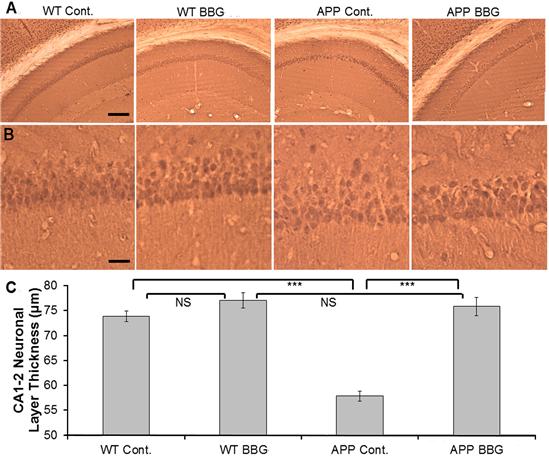Media Center
A multimedia mosaic of moments at GIST
GIST Excellence
[Press Release] Professor Inchan Kwon collaborated with American researchers to inhibit neural loss caused by Alzheimer"s Disease
- 엘리스 리
- REG_DATE : 2016.04.19
- HIT : 885
Triphenylmethane food dye analog, Brilliant Blue G, prevents
neural loss in mouse model mimicking signs of Alzheimer"s Disease
Research published in Current Alzheimer Research

6E10 staining in CA1 pyramidal cell layer of hippocampus, in WT and APP transgenic mice with oral Brilliant Blue G (BBG) administration. Treatment with 6E10 antibody leads to visualization of dark accumulation in APP mice hippocampus neurons (black asteriks), while some unstained cells remain discernable (white asterisk). Compared to BBG fed mice (C ), a larger number of cells were stained in APP-Cont mice. The cells in APP-Cont brains were less organized, and they were dysmorphic, displaying wider spaces between discernable somata.
Alzheimer"s Disease is a form of dementia characterized by neurofibrillary tau protein tangles, neuronal loss, and the accumulation of insoluble peptide aggregates, which are composed primarily of neurotoxic amyloid-β (Aβ). One hypothesis for Alzheimer"s Disease development posits that Aβ accumulation in the brain is toxic and causes neurons to die, which leads to cognitive loss that is seen in patients with Alzheimer"s. Therefore, reducing Aβ accumulation in the brain may be a promising method to treat Alzheimer"s.
Professor Inchan Kwon of the School of Materials Science and Engineering at the Gwangju Institute of Science and Technology (GIST) collaborated with Professor Alev Erisir of the Department of Psychology at the University of Virginia and Professor Jacob A. Irwin of the Department of Chemical Engineering at the University of Virgina have shown in previous research that the triphenylmethane food dye analog, Brilliant Blue G, is a novel modulator of in vitro Aβ40-aggregation and Aβ cytotoxicity in cell-based assays.
For their current research entitled "Oral Triphenylmethane Food Dye Analog, Brilliant Blue G (BBG), Prevents Neuronal Loss in APPSwDI/NOS2-/- Mouse Model" authored by Jacob A. Irwin, Alev Erisir, and Inchan Kwon and published on February 8, 2016, in Current Alzheimer Research, the researchers evaluated the efficacy of BBG to moderate in vivo Aβ accumulation in mouse models by feeding 2,000 mg/kg/day of BBG for 3 months to APPSwDI/NOS2-/-mice, which are transgenic models of AD.

Immunohistochemical assessment of 6E10 staining in the cortex neuropil with oral Brilliant Blue G (BBG) administration. A,B The 6E10 immunoreaction lead to visualization of neurons (black asterisk) in all layers of the cerebral cortex (Ctx.) in APP mice. Extracellular accumulation of 6E10 stained product was also prevalent throughout cortex (B), as well as in dentate gyrus (not shown). The size of these amyloid accumulations (plaques) ranged from punctate (arrowheads) to 80-100 μm (black arrows), leading to a diffuse staining appearance in cortex. Scale bar = 100 μm for A, and 200 μm for B. C, Quantification of cortex neuropil 6E10 plaque staining expressed as the average percentage of area occupied by 6E10-positive manually traced diffuse plaques per total area analyzed ± SEM (n ≥ 50 for 6E10, 2-3 animals per transgenic group). NS indicates no statistically significant difference detected compared to APPSwDI/NOS2-/- untreated control group (p > 0.1 from one-way ANOVA test). *** = p < 0.0001 (one-way ANOVA + Tukey’s post-hoc analysis).

The image shows the experimental results obtained using the mouse model. The mice that consumed the BBG had less neural loss when compared to mice from the control group. Photo of Professor Inchan Kwon.
The results indicated that oral ingestion of BBG had significant effects on neuron survival and intracellular APP/Aβ accumulation in the hippocampus and effectively reduced AD related neuronal loss in the hippocampus of a transgenic model.
Professor Inchan Kwon said, "For the treatment of Alzheimer"s Disease, this study offers promising new potential for therapeutic development as food dye analog-based small molecules can easily be added to food and that would be a convenient way to help treat reluctant patients with diminished mental capacities."